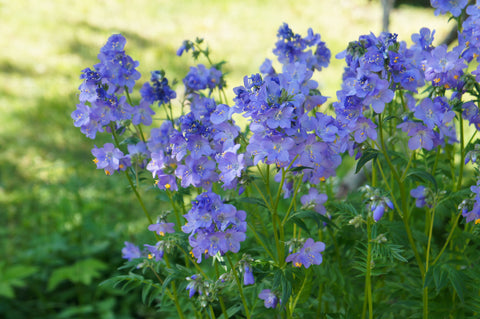

Jacob's Ladder - Polemonium
Jacob's ladder (Polemonium) is a perennial flowering plant. Jacob's Ladder is a member of the Polemoniaceae family and is also known by other common names such as Greek valerian, charity, and stairway to heaven.
The plant generally grows to a height of 30-60cm (12-24 inches) and produces attractive foliage in a ladder-like formation along the stem. The leaves are pinnate or bipinnate and have a fern-like appearance. The flowers of Jacob's ladder are usually blue, violet, or white and bloom in late spring or early summer. The flowers are bell-shaped and have five petals.
Jacob's ladder prefers partial shade to full shade and moist, well-drained soil.
It can grow in USDA hardiness zones 3-8. The plant is often used in woodland, shade, and cottage gardens, and it can also be used as a ground cover or planted in containers.
In addition to its ornamental value, Jacob's ladder has been used for medicinal purposes. The roots and leaves contain alkaloids used to treat various ailments, including respiratory infections, fever, and digestive disorders. However, it is essential to remember that the plant can be toxic if consumed in large quantities. Medical advice should always be sought before using any plant for medicinal purposes.
How to plant Jacob's Ladder plants?
- Choose a suitable location: Jacob's ladder prefers partial shade to full shade and moist, well-drained soil. Choose a location that meets these requirements.
- Prepare the soil: Jacob's ladder grows best in soil rich in organic matter. Prep the ground by adding compost or well-rotted manure to the planting area and working it in.
- Dig a hole: Dig a hole a little larger than the plant's root ball.
- Plant Jacob's ladder: Place the plant in the hole and fill the hole with soil. The tip of the root should be level with the surrounding soil.
- Water the plant: To settle the soil around the roots, water the plant well.
- Mulch: Apply an inch or so of mulch around the plant to help keep moisture in the soil and suppress weeds. You can use an organic mulch such as shredded bark or leaves.
- Care: Continue to water the plant regularly to keep the soil moist. Fertilize the plant once or twice a year with a balanced fertilizer. Prune the plant after it has finished flowering to encourage new growth.
Note: If you are planting multiple Jacob's ladder plants, space them about 12-18 inches apart to allow their spread as they mature.
PLANTING JACOB'S LADDER (POLEMONIUM CAERULEUM) CAN OFFER SEVERAL BENEFITS, INCLUDING:
- Ornamental value: Jacob's ladder is an attractive flowering plant with delicate foliage and bell-shaped flowers. It can add color and texture to gardens, containers, and other outdoor spaces.
- Low maintenance: Jacob's ladder is a relatively low-maintenance plant that requires minimal care once established. It can tolerate partial shade and moist, well-drained soil, making it a good choice for gardens with these conditions.
- Wildlife attraction: The flowers of Jacob's ladder can attract butterflies, bees, and other pollinators to your garden. This can help support local ecosystems and promote biodiversity.
- Medicinal properties: While the medicinal use of Jacob's ladder is only recommended with proper medical advice, the plant contains alkaloids used in traditional medicine to treat various ailments.
- Ground cover: Jacob's ladder can be used as a ground cover in areas with partial shade. It can help prevent erosion, suppress weed growth, and add visual interest to the landscape.
BUY JACOB'S LADDER ONLINE AT NANCE PLANTS.
FAQ
1. What is the best growing conditions for Jacob's Ladder plants?
A. Plant Jacob's ladder in well-draining soil that is rich in organic matter. It prefers a slightly acidic to neutral soil pH.
2. Is Jacob's Ladder easy to grow?
A. Yes, Jacob's Ladder are easy to grow once established.
Overall, planting Jacob's ladder can offer aesthetic and ecological benefits, making it a versatile and worthwhile addition to many outdoor spaces.
One Year Guarantee on all Perennials & Ferns. See Healthy Plant Guarantee for more details.
Color:
Purple
Ships As:
Root/Rhizome
Season:
Spring, Summer
Zone:
4-8
Exposure:
Full to Partial Shade
Deer Resistant:
Yes
Native:
Yes




